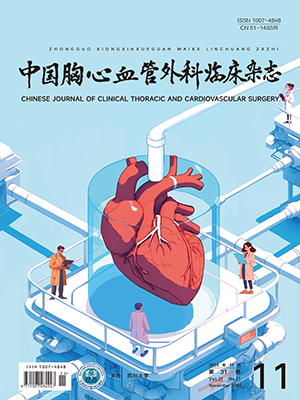| 1. |
鲍然.主动脉夹层动脉瘤的诊治体会.中国社区医师:医学专业, 2012, 14 (7):67.
|
| 2. |
肖志华, 陈燕.主动脉夹层误诊分析11例.中国社区医师:医学专业, 2011, 13 (16):244.
|
| 3. |
吴孟超, 吴在德, 主编.黄家驷外科学.第7版.人民卫生出版社, 2008. 2257-2261.
|
| 4. |
Tsai TT, Trimarchi S, Nienaber CA. Acute aortic dissection:persp-ectives from the International Registry of Acute Aortic Dissection (IRAD). Eur J Vasc Endovasc Surg, 2009, 37 (2):149-159.
|
| 5. |
Hagan PG, Nienaber CA, Isselbacher EM, et al. The International Registry of Aortic Dissection (IRAD):New insights into an old disease. JAMA, 2000, 283 (7):897-903.
|
| 6. |
Song TK, Donayre CE, Walot I, et al. Endograft Exclusion of acute and chronic descending thoracic aortic dissections. J Vas Surg, 2006, 43 (2):247-258.
|
| 7. |
郝良玉.覆膜支架腔内隔绝术治疗Stanford-B型夹层动脉瘤11例.内蒙古医学杂志, 2008, 40 (10):1241-1242.
|
| 8. |
皮勇, 陈曹阳, 李智英, 等.腔内隔绝术治疗胸主动脉夹层动脉瘤79例临床应用研究.亚太传统医药, 2012, 8 (9):90-92.
|
| 9. |
Tsai TT, Nienaber CA, Eagle KA. Acute Aortic Syndrnmes. Circulation, 2005, 112:3802-3813.
|
| 10. |
杨栋, 潘扬.腔内隔绝术治疗胸主动脉夹层.贵阳医学院学报, 2010, 35 (3):314-316.
|
| 11. |
王军, 王高明, 许飚, 等.腔内隔绝治疗77例StanfordB型夹层动脉瘤的报告.医学研究生学报, 2012, 25 (8):841-843.
|
| 12. |
张明宇, 夏洪远, 董玉梅, 等.腔内隔绝术治疗Stanford B型胸主动脉夹层18例.哈尔滨医科大学学报, 2011, 45 (3):286-288.
|
| 13. |
徐克, 吴瑕, 陈冉, 等.腔内修复术治疗DeBakeyⅢ型主动脉夹层动脉瘤中远期疗效评价.介入放射学杂志, 2008, 17 (8):567-569.
|
| 14. |
张永杰, 霍鑫.腔内修复术治疗胸主动脉夹层.中国普通外科杂志, 2009, 18 (12):1238-1240.
|
| 15. |
陈伟, 杨建勇, 庄文权, 等.腔内隔绝术治疗胸主动脉夹层.中华放射学杂志, 2013, 37 (11):1007-1011.
|




